A Necessity-Based Optimization Approach for Closed-Loop Logistics Considering Carbon Emission Penalties and Rewards under Uncertainty
Abstract
:1. Introduction
2. Literature Review
2.1. Closed-Loop Logistics
2.2. Carbon Emissions
2.3. Uncertainty
2.4. Solution Algorithms
3. Problem Description and Uncertainty Modeling
3.1. Problem Definition
- (1)
- The amount of carbon dioxide emitted as a result of energy consumption during the operation of each center, that is, the carbon emissions during the operation process within the facilities. This type of carbon emission is mainly generated by electricity consumption, fuel consumption, and heat consumption. This study only considers the carbon emissions generated by electricity consumption;
- (2)
- The amount of carbon dioxide emissions from energy consumption during transportation between centers. Due to differences in factors, such as vehicle weight [16], transportation distance [23], road slope, and road congestion, the carbon emissions generated as a result of fuel consumption vary. This study only considers vehicle weight and transportation distance. In general, the emission of carbon dioxide is directly proportional to energy consumption.
3.2. Model Assumptions and Symbols
3.3. Objective Function and Constraints of the Fuzzy Optimization Model
3.4. Defuzzified Model Formulation
4. Solution Method
4.1. Encoding and Decoding Operation
| Algorithm 1: Encoding procedure adopted within the proposed VPGA algorithm |
| Input: |
| : Total number of suppliers |
| : Total number of factories |
| : Total number of distribution centers |
| : Total number of consumption areas |
| : Total number of inspection/disassembly centers |
| : Total number of landfill sites |
| Output: |
| : realization degree |
| : priority matrix, where , , , , , . |
| For q = 1, 2, …, 6 |
| Step 1: Generate as a random number between [0.5, 1] |
| End |
| Step2: Randomly arrange 1 to numbers on the Empty matrix to obtain a matrix with rows and columns and let = . |
| Step3: Randomly arrange 1 to numbers on the Empty matrix to obtain a matrix with rows and columns and let = . |
| Step4: Randomly arrange 1 to numbers on the Empty matrix to obtain a matrix with rows and columns and let = . |
| Step5: Randomly arrange 1 to numbers on the Empty matrix to obtain a matrix with rows and columns and let = . |
| Step6: Randomly arrange 1 to numbers on the Empty matrix to obtain a matrix with rows and columns and let = . |
| Step7: Randomly arrange 1 to numbers on the Empty matrix to obtain a matrix with rows and columns and let = . |
| Step8: Randomly arrange 1 to numbers on the Empty matrix to obtain a matrix with rows and columns and let = . |
| Note: The symbols used in this operation are independent of the symbols used in the model. |
| Algorithm 2: Decoding procedure adopted within the proposed VPGA algorithm |
| Input: |
| : Set of starting points |
| : Set of destinations |
| : The ability of starting point , |
| : The demand for destination , |
| : priority matrix |
| Output: |
| : Transportation volume from node to node |
| Step1: let |
| While |
| Step2: |
| Step3: Update demand and capacity: , |
| Step4: If then If then |
| Step5: If then output else return to Step2 |
| End |
| Algorithm 3: Decoding procedure adopted within the proposed VPGA algorithm |
| Input: : realization degree |
| : priority matrix |
| Output: |
| Step1: Calculate using Algorithm 2 |
| Step2: Calculate using Algorithm 2 |
| Step3: Calculate using Algorithm 2 |
| Step4: Calculate using Algorithm 2 |
| Step5: Calculate using Algorithm 2 |
| Step6: Calculate using Algorithm 2 |
| Step7: Calculate using Algorithm 2 |
4.2. Fitness and Selection Operations
4.3. Crossover Operation and Mutation Operation
- (1)
- The crossover operation used in the VPGA algorithm is based on a well-known single-point crossover method.
- (2)
- The method of mutation operation (exchange mutation or swap mutation) can be conducted based on the following steps:
5. Numerical Experiments
5.1. Input Data Generation
5.2. Evaluation of the Candidate Solution Approaches
5.3. Sensitivity Analysis and Managerial Insights
6. Conclusions
Author Contributions
Funding
Institutional Review Board Statement
Informed Consent Statement
Data Availability Statement
Conflicts of Interest
References
- Xu, Z.; Elomri, A.; Liu, W.; Liu, H.; Li, M. Robust global reverse logistics network redesign for high-grade plastic wastes recycling. Waste Manag. 2021, 134, 251–262. [Google Scholar] [CrossRef] [PubMed]
- Govindan, K.; Soleimani, H.; Kannan, D. Reverse logistics and closed-loop supply chain: A comprehensive review to explore the future. Eur. J. Oper. Res. 2015, 240, 603–626. [Google Scholar] [CrossRef]
- Feng, Y.; Dong, Z. Comparative lifecycle costs and emissions of electrified powertrains for light-duty logistics trucks. Transp. Res. Part D Transp. Environ. 2023, 117, 103672. [Google Scholar] [CrossRef]
- Yi, W.; Zhen, L.; Jin, Y. Stackelberg game analysis of government subsidy on sustainable off-site construction and low-carbon logistics. Clean. Logist. Supply Chain 2021, 2, 100013. [Google Scholar]
- Jafari, H.; Eslami, M.H.; Paulraj, A. Postponement and logistics flexibility in retailing: The moderating role of logistics integration and demand uncertainty. Int. J. Prod. Econ. 2021, 243, 108319. [Google Scholar] [CrossRef]
- Fathollahi-Fard, A.M.; Dulebenets, M.A.; Hajiaghaei–Keshteli, M.; Tavakkoli-Moghaddam, R.; Safaeian, M.; Mirzahosseinian, H. Two hybrid meta-heuristic algorithms for a dual-channel closed-loop supply chain network design problem in the tire industry under uncertainty. Adv. Eng. Inform. 2021, 50, 101418. [Google Scholar] [CrossRef]
- Asghari, M.; Afshari, H.; Al-e-hashem, S.M.J.; Fathollahi-Fard, A.M.; Dulebenets, M.A. Pricing and advertising decisions in a direct-sales closed-loop supply chain. Comput. Ind. Eng. 2022, 171, 108439. [Google Scholar] [CrossRef]
- Gholizadeh, H.; Goh, M.; Fazlollahtabar, H.; Mamashli, Z. Modelling uncertainty in sustainable-green integrated reverse logistics network using metaheuristics optimization. Comput. Ind. Eng. 2021, 163, 107828. [Google Scholar] [CrossRef]
- Kulińska, E.; Kulińska, K. Development of ride-sourcing services and sustainable city logistics. Transp. Res. Procedia 2019, 39, 252–259. [Google Scholar] [CrossRef]
- Salehi-Amiri, A.; Zahedi, A.; Akbapour, N.; Hajiaghaei-Keshteli, M. Designing a sustainable closed-loop supply chain network for walnut industry. Renew. Sustain. Energy Rev. 2021, 141, 110821. [Google Scholar] [CrossRef]
- Rajabi-Kafshgar, A.; Gholian-Jouybari, F.; Seyedi, I.; Hajiaghaei-Keshteli, M. Utilizing hybrid metaheuristic approach to design an agricultural closed-loop supply chain network. Expert Syst. Appl. 2023, 217, 119504. [Google Scholar] [CrossRef]
- Prajapati, D.; Pratap, S.; Zhang, M.; Lakshay; Huang, G.Q. Sustainable forward-reverse logistics for multi-product delivery and pickup in B2C e-commerce towards the circular economy. Int. J. Prod. Econ. 2022, 253, 108606. [Google Scholar] [CrossRef]
- Kim, Y.G.; Chung, B.D. Closed-loop supply chain network design considering reshoring drivers. Omega 2022, 109, 102610. [Google Scholar] [CrossRef]
- Lu, S.; Chen, C.; Wang, Y.; Li, Z.; Li, X. Coordinated scheduling of production and logistics for large-scale closed-loop manufacturing using Benders decomposition optimization. Adv. Eng. Inform. 2022, 55, 101848. [Google Scholar] [CrossRef]
- Ullah, M. Impact of transportation and carbon emissions on reverse channel selection in closed-loop supply chain management. J. Clean. Prod. 2023, 394, 136370. [Google Scholar] [CrossRef]
- Köseli, İ.; Soysal, M.; Çimen, M.; Sel, Ç. Optimizing food logistics through a stochastic inventory routing problem under energy, waste and workforce concerns. J. Clean. Prod. 2023, 389, 136094. [Google Scholar] [CrossRef]
- Mondal, A.; Roy, S.K. Multi-objective sustainable opened- and closed-loop supply chain under mixed uncertainty during COVID-19 pandemic situation. Comput. Ind. Eng. 2021, 159, 107453. [Google Scholar] [CrossRef]
- Wang, H.F.; Hsu, H.W. A closed-loop logistic model with a spanning-tree based genetic algorithm. Comput. Oper. Res. 2010, 37, 376–389. [Google Scholar] [CrossRef]
- Benjaafar, S.; Li, Y.; Daskin, M. Carbon footprint and the management of supply chains: Insights from simple models. IEEE Trans. Autom. Sci. Eng. 2013, 10, 99–116. [Google Scholar] [CrossRef]
- Wang, J.; Lim, M.K.; Tseng, M.L.; Yang, Y. Promoting low carbon agenda in the urban logistics network distribution system. J. Clean. Prod. 2019, 211, 146–160. [Google Scholar] [CrossRef]
- Wang, J.; Wang, Q.; Yu, M. Green supply chain network design considering chain-to-chain competition on price and carbon emission. Comput. Ind. Eng. 2020, 145, 106503. [Google Scholar] [CrossRef]
- Purnomo, M.; Wangsa, I.; Rizky, N.; Jauhari, W.; Zahria, I. A multi-echelon fish closed-loop supply chain network problem with carbon emission and traceability. Expert Syst. Appl. 2022, 210, 118416. [Google Scholar] [CrossRef]
- Hashmi, N.; Jalil, S.; Javaid, S. A multi-objective model for closed-loop supply chain network based on carbon tax with two fold uncertainty: An application to leather industry. Comput. Ind. Eng. 2022, 173, 108724. [Google Scholar] [CrossRef]
- Xiao, G.; Lu, Q.; Ni, A.; Zhang, C. Research on carbon emissions of public bikes based on the life cycle theory. Transp. Lett. 2023, 15, 278–295. [Google Scholar]
- Rahimi, M.; Ghezavati, V. Sustainable multi-period reverse logistics network design and planning under uncertainty utilizing conditional value at risk (cvar) for recycling construction and demolition waste. J. Clean. Prod. 2018, 172 Pt 2, 1567–1581. [Google Scholar] [CrossRef]
- Kchaou-Boujelben, M.; Bensalem, M.; Jemai, Z. Bi-objective stochastic closed-loop supply chain network design under uncertain quantity and quality of returns. Comput. Ind. Eng. 2023, 181, 109308. [Google Scholar] [CrossRef]
- Garai, A.; Sarkar, B. Economically independent reverse logistics of customer-centric closed-loop supply chain for herbal medicines and biofuel. J. Clean. Prod. 2021, 334, 129977. [Google Scholar] [CrossRef]
- Kim, J.; Chung, B.D.; Kang, Y.; Jeong, B. Robust optimization model for closed-loop supply chain planning under reverse logistics flow and demand uncertainty. J. Clean. Prod. 2018, 196, 1314–1328. [Google Scholar] [CrossRef]
- Shahparvari, S.; Soleimani, H.; Govindan, K.; Bodaghi, B.; Fard, M.T.; Jafari, H. Closing the loop: Redesigning sustainable reverse logistics network in uncertain supply chains. Comput. Ind. Eng. 2021, 157, 107093. [Google Scholar] [CrossRef]
- Eslamipoor, R. A two-stage stochastic planning model for locating product collection centers in green logistics networks. Clean. Logist. Sup. 2022, 6, 100091. [Google Scholar] [CrossRef]
- Inuiguchi, M.; Ramilk, J. Possibilistic linear programming: A brief review of fuzzy mathematical programming and a comparison with stochastic programming in portfolio selection problem. Fuzzy Set. Syst. 2000, 111, 3–28. [Google Scholar] [CrossRef]
- Talaei, M.; Moghaddam, B.F.; Pishvaee, M.S.; Bozorgi-Amiri, A.; Gholamnejad, S. A robust fuzzy optimization model for carbon-efficient closed-loop supply chain network design problem: A numerical illustration in electronics industry. J. Clean. Prod. 2016, 113, 662–673. [Google Scholar] [CrossRef]
- Gen, M.; Syarif, A. Hybrid genetic algorithm for multi-time period production/distribution planning. Comput. Ind. Eng. 2005, 48, 799–809. [Google Scholar] [CrossRef]
- Syarif, A.; Yun, Y.S.; Gen, M. Study on multi-stage logistic chain network: A spanning tree-based genetic algorithm approach. Comput. Ind. Eng. 2002, 43, 299–314. [Google Scholar] [CrossRef]
- Delbem, A.C.B.; De Lima, T.W.; Telles, G.P. Efficient forest data structure for evolutionary algorithms applied to network design. IEEE Trans. Evolut. Comput. 2012, 16, 829–846. [Google Scholar] [CrossRef]
- Choudhary, A.; Sarkar, S.; Settur, S.; Tiwari, M.K. A carbon market sensitive optimization model for integrated forward–reverse logistics. Int. J. Prod. Econ. 2015, 164, 433–444. [Google Scholar] [CrossRef]
- Gen, M.; Altiparmak, F.; Lin, L. A genetic algorithm for two-stage transportation problem using priority-based encoding. Or Spectr. 2006, 28, 337–354. [Google Scholar] [CrossRef]
- Lee, J.E.; Gen, M.; Rhee, K.G. Network model and optimization of reverse logistics by hybrid genetic algorithm. Comput. Ind. Eng. 2009, 56, 951–964. [Google Scholar] [CrossRef]
- Raj, K.; Rajendran, C. A genetic algorithm for solving the fixed-charge transportation model: Two-stage problem. Comput. Oper. Res. 2012, 39, 2016–2032. [Google Scholar]
- Lotfi, M.M.; Tavakkoli-Moghaddam, R. A genetic algorithm using priority-based encoding with new operators for fixed charge transportation problems. Appl. Soft Comput. 2013, 13, 2711–2726. [Google Scholar] [CrossRef]
- Roghanian, E.; Pazhoheshfar, P. An optimization model for reverse logistics network under stochastic environment by using genetic algorithm. J. Manuf. Syst. 2014, 33, 348–356. [Google Scholar] [CrossRef]
- Afrouzy, Z.A.; Nasseri, S.H.; Mahdavi, I. A genetic algorithm for supply chain configuration with new product development. Comput. Ind. Eng. 2016, 101, 440–454. [Google Scholar] [CrossRef]
- Tari, F.G.; Hashemi, Z. A priority based genetic algorithm for nonlinear transportation costs problems. Comput. Ind. Eng. 2016, 96, 86–95. [Google Scholar] [CrossRef]
- Mitsuo, G.; Lin, L.; Yun, Y.S.; Hisaki, I. Recent advances in hybrid priority-based genetic algorithms for logistics and SCM network design. Comput. Ind. Eng. 2018, 125, 394–412. [Google Scholar]
- Cheraghalipour, A.; Paydar, M.M.; Hajiaghaei-Keshtelia, M. A bi-objective optimization for citrus closed-loop supply chain using pareto-based algorithms. Appl. Soft Comput. 2018, 69, 33–59. [Google Scholar] [CrossRef]

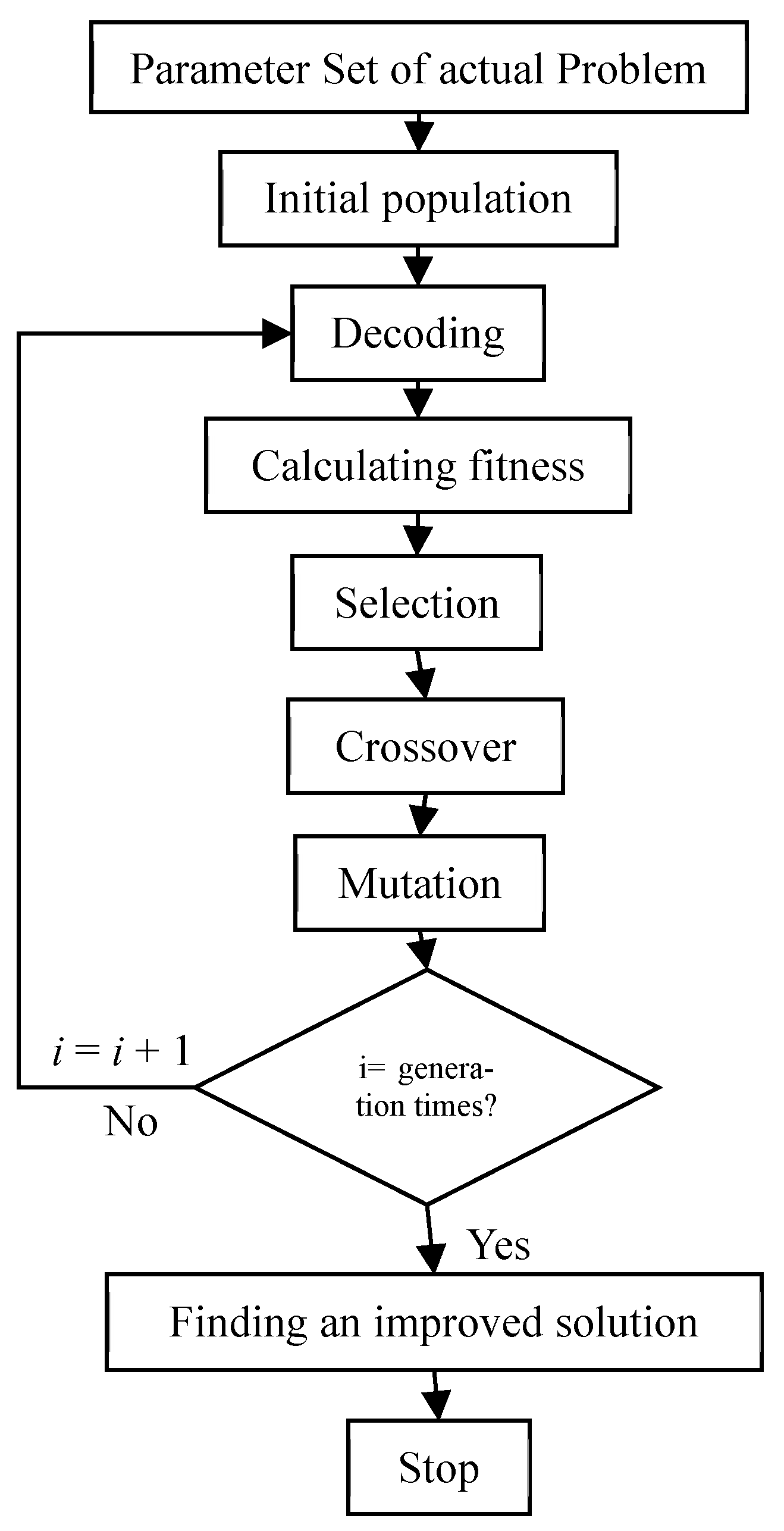

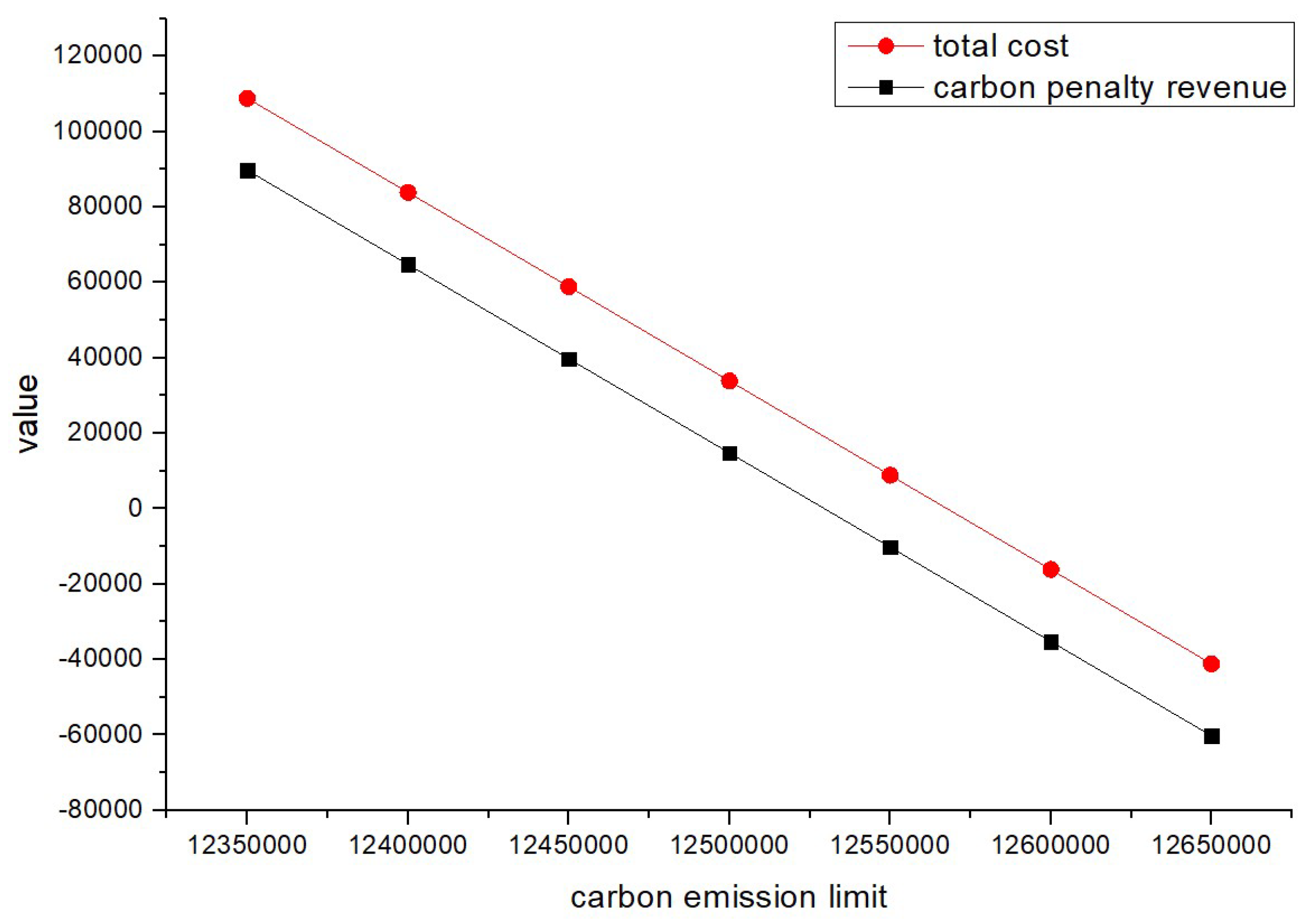
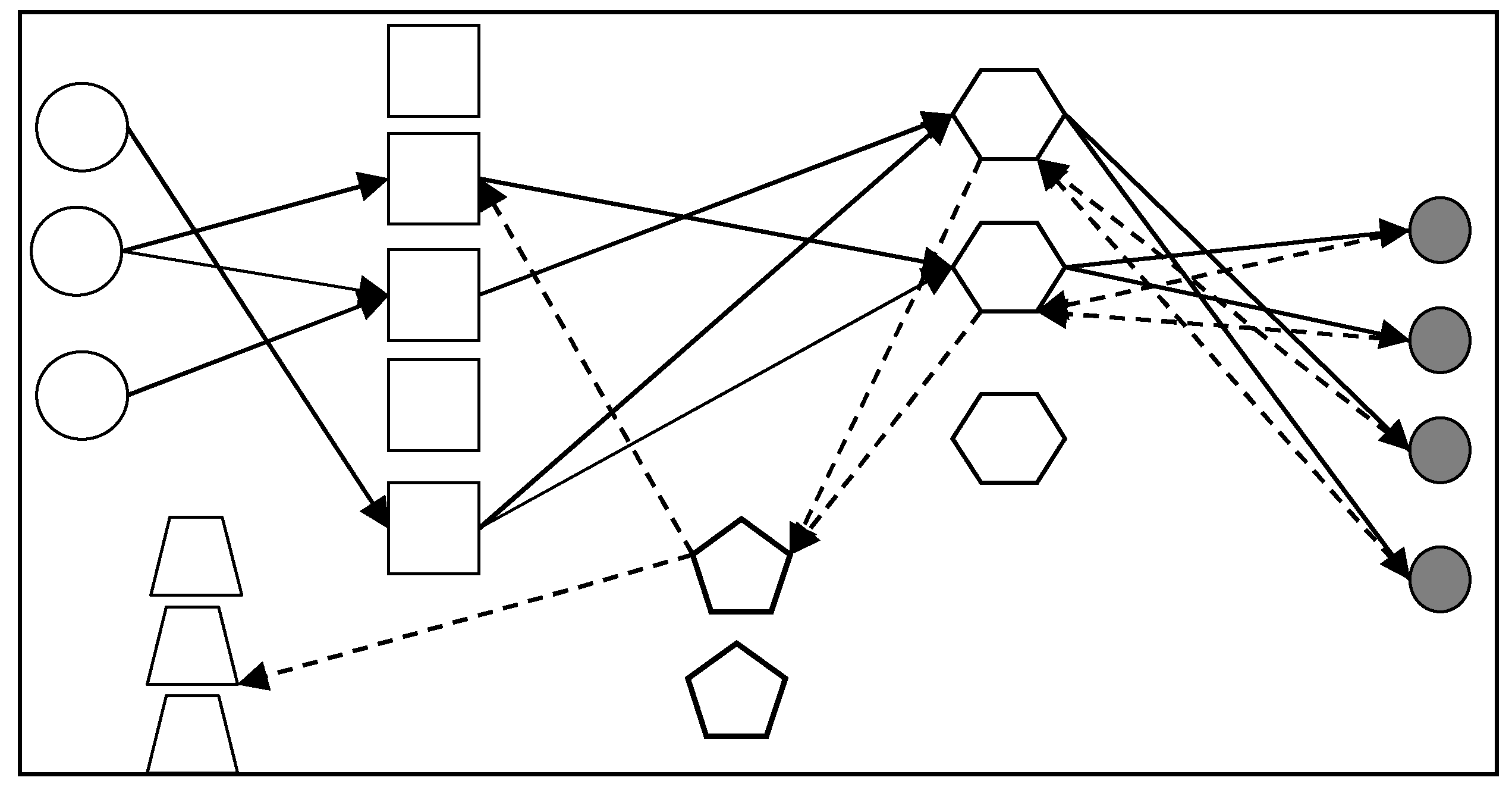
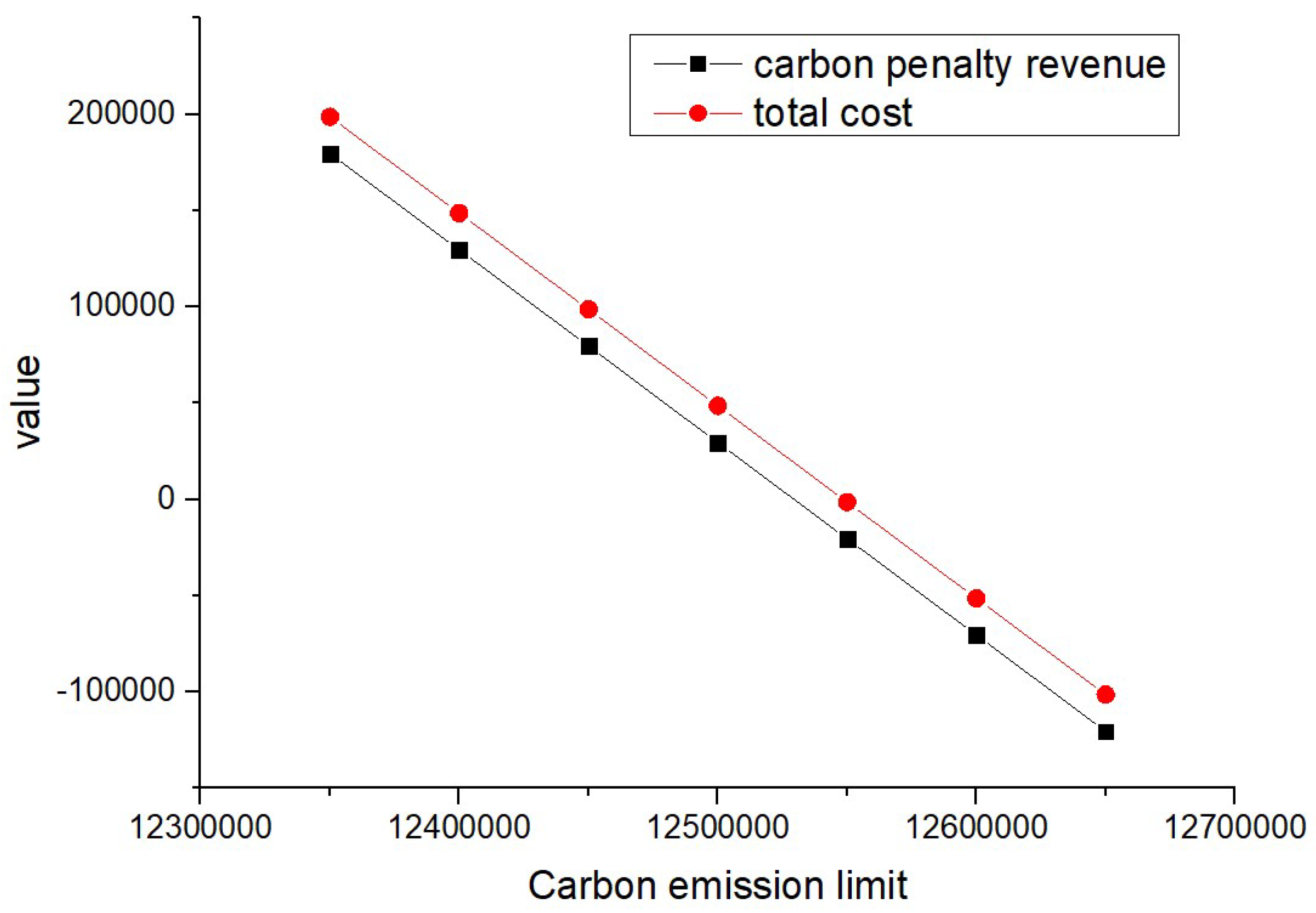
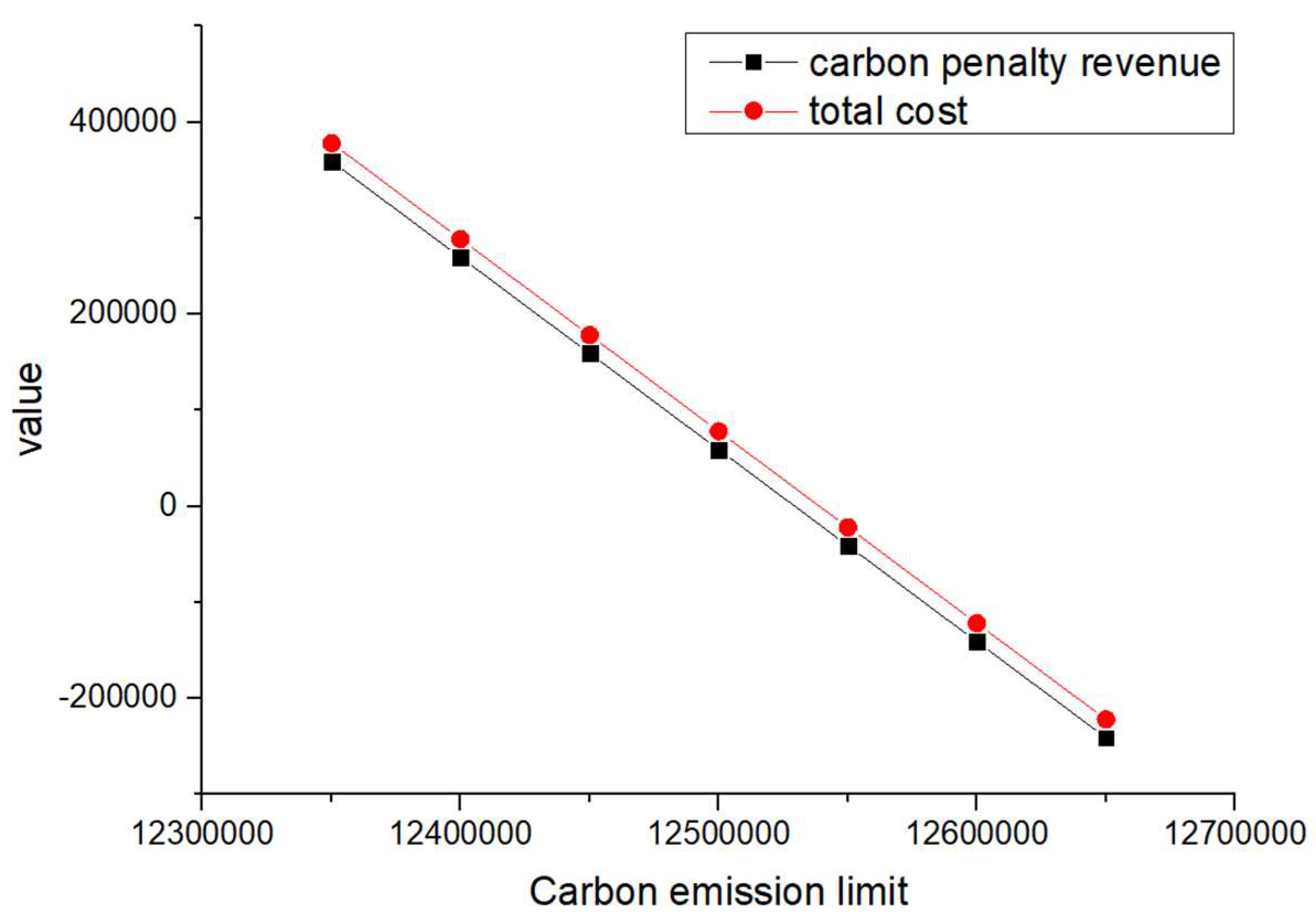
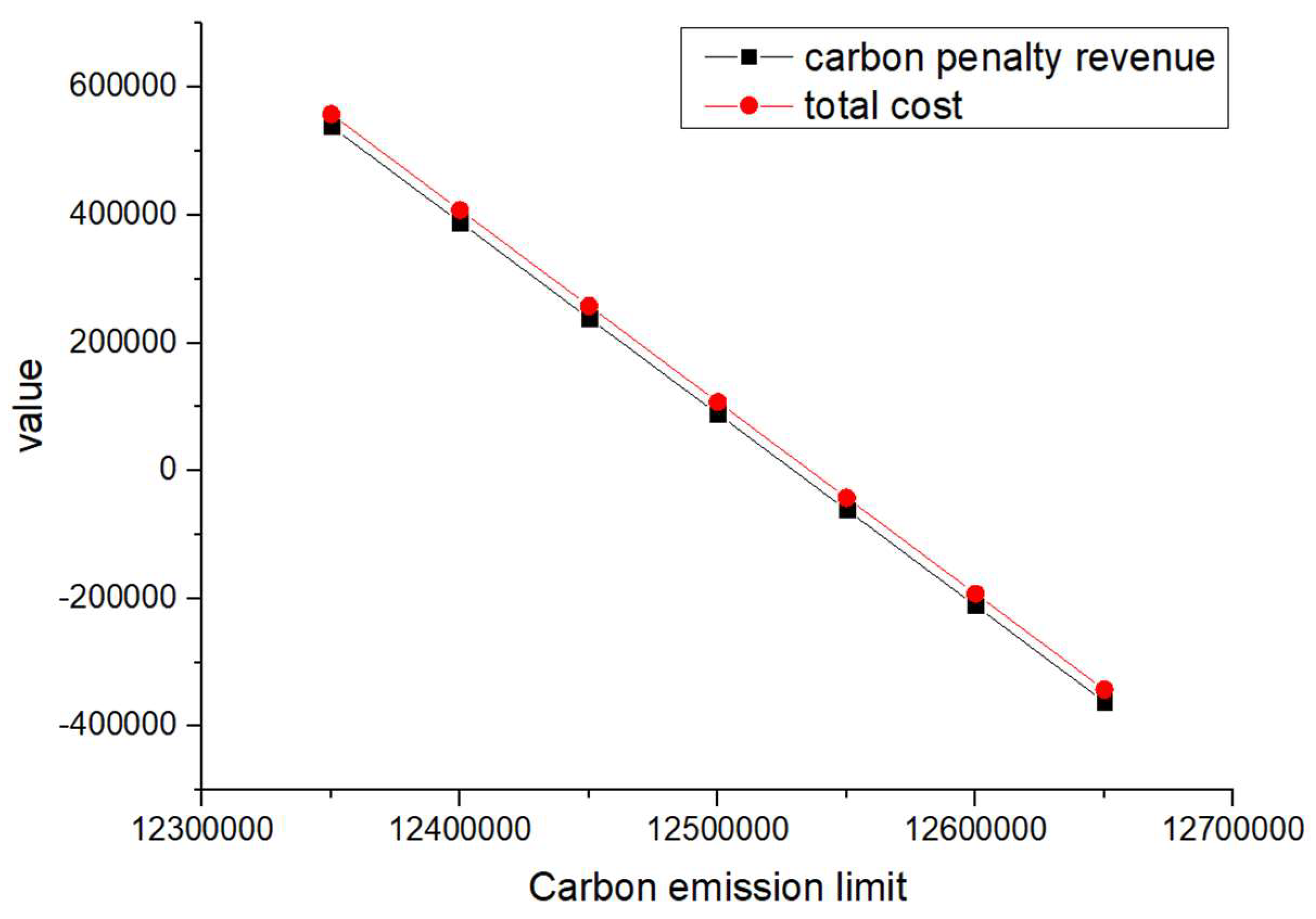
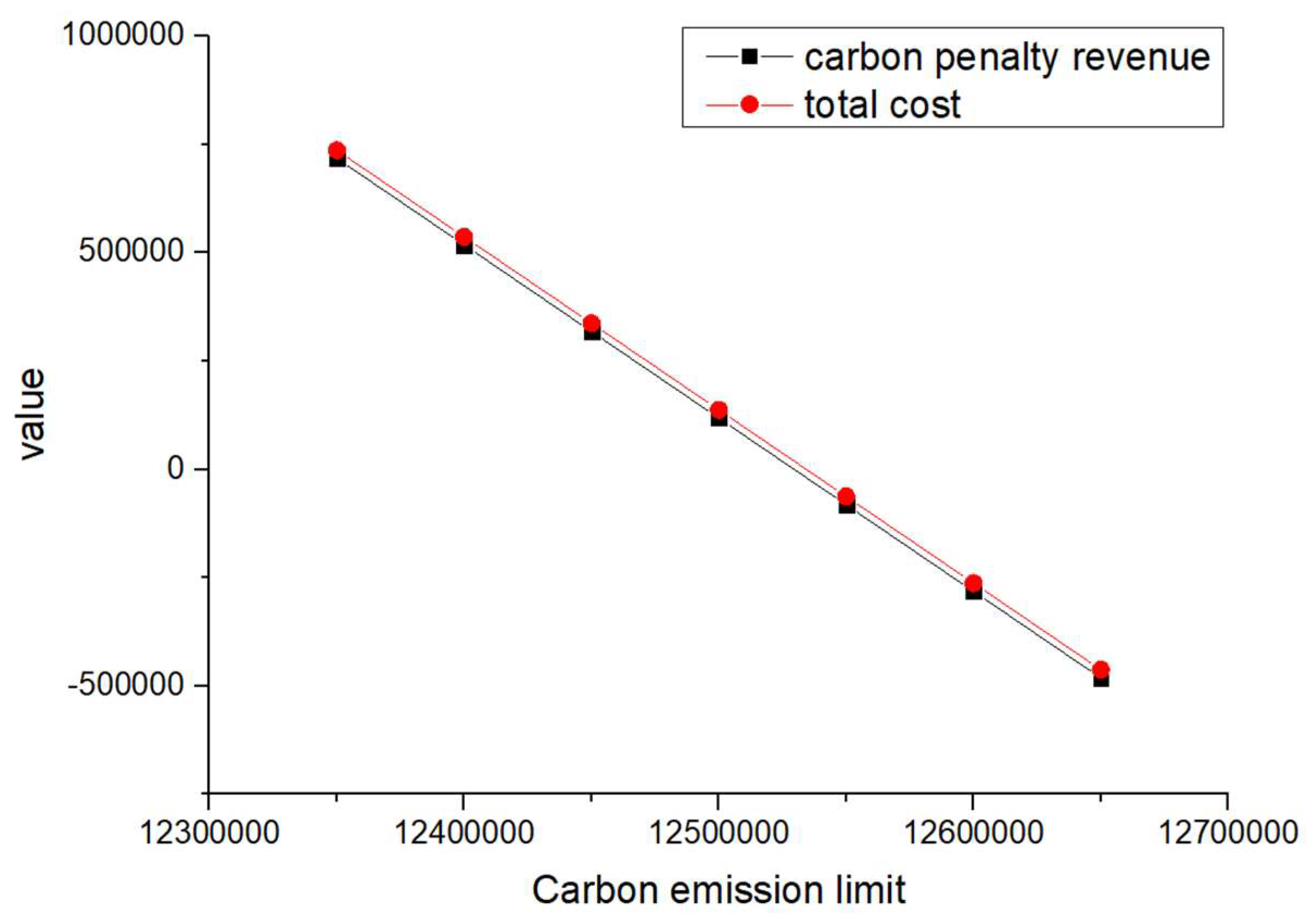
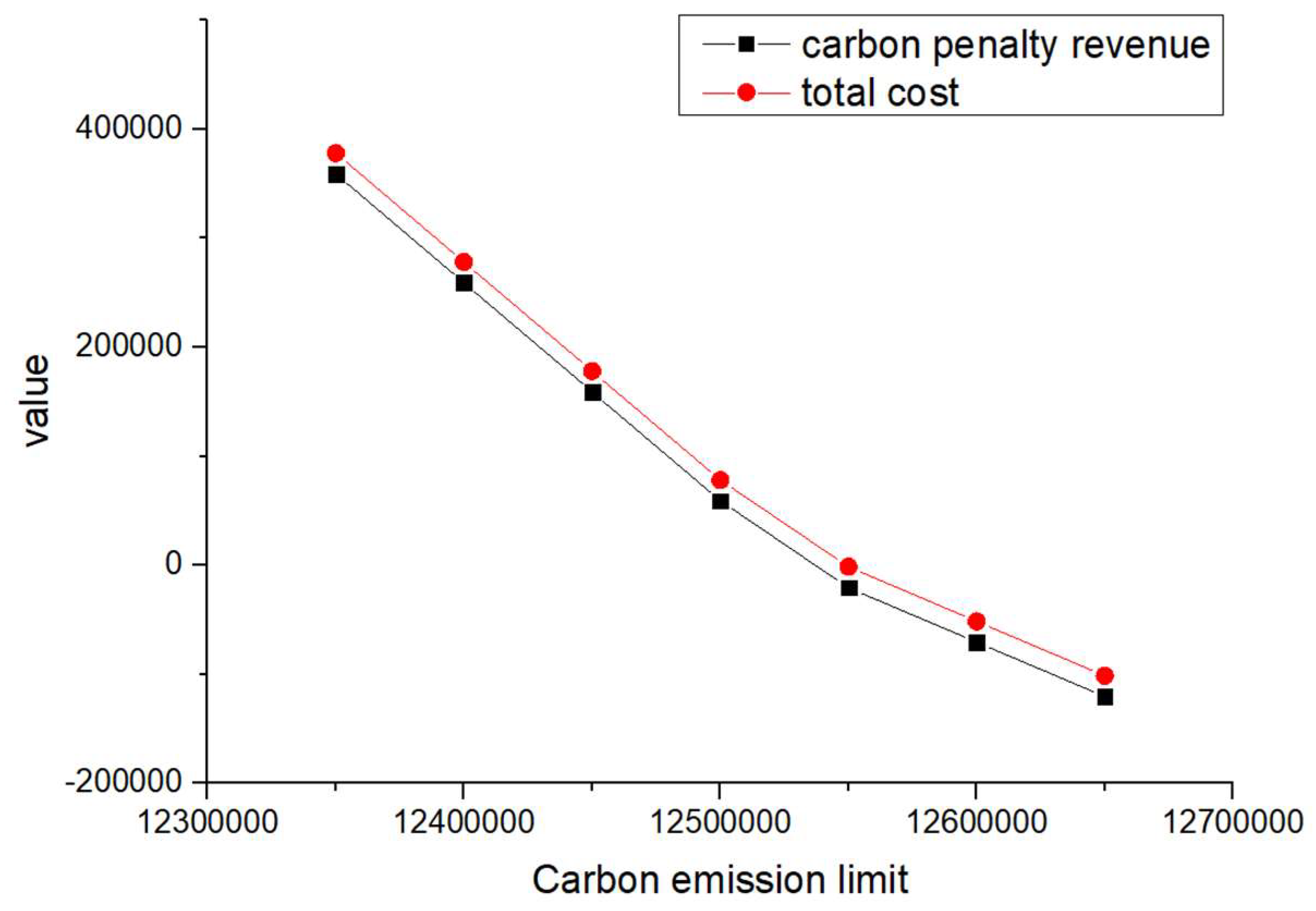



| Sets | Description |
|---|---|
| Parameters | Ratio or Uniform Distribution | Description |
|---|---|---|
| [300, 500] | Capacity of supplier | |
| [300, 600] | Fuzzy processing capability of factory | |
| [550, 900] | Fuzzy capacity of distribution center | |
| [350, 550] | Fuzzy capacity of detection/disassembly center | |
| [15, 30] | Fuzzy capacity of landfill point | |
| 10% | Percentage of reverse capability of distribution center in total capacity | |
| 10% | Recovery rate of customer zone | |
| 10% | Landfill rate of detection/disassembly center | |
| [250, 550] | Fuzzy demand of customer zone | |
| [1, 40] | Distance of products from supplier to factory , products from factory to distribution center , products from distribution center to customer zone , products from distribution center to detection/disassembly center , products from detection/disassembly center to factory , returned products from customer zone to distribution center , returned products from detection/disassembly center to landfill point | |
| [800, 1800] | Fixed cost of opening factory and distribution center | |
| [100, 300] | Fixed cost of opening detection/disassembly center | |
| [200, 400] | Fixed cost of opening landfill point | |
| [2,300,000, 2,400,000] | Fixed CO2 emission coefficient of factory | |
| [84,000, 85,000] | Fixed CO2 emission coefficient of distribution center | |
| [840,000, 850,000] | Fixed CO2 emission coefficient of detection/disassembly center | |
| [825,000, 830,000] | Fixed CO2 emission coefficient of landfill point | |
| , , , | [500, 1000] | CO2 emission coefficient of unit products processed in factories, distribution centers, testing/dismantling centers, and landfill sites |
| [2100, 2900] | Fuzzy landfill cost per unit of product | |
| -- | A sufficiently large number | |
| 0.5 | Fuzzy penalty cost for unit carbon emissions exceeding the quota for an enterprise | |
| 0.5 | Fuzzy reward amount for a company’s carbon emissions per unit below the limit | |
| 550 | CO2 emission coefficient per vehicle per kilometer | |
| 5 | Vehicle loading capacity | |
| [1, 5] | Fuzzy transportation cost per kilometer per unit of product | |
| -- | CO2 emission limits for an enterprise |
| Decision Variables | Description |
|---|---|
= 0. | |
| = 0. | |
| = 0. | |
| = 0. | |
| Carbon emissions of an enterprise over the limit | |
| Carbon emissions of an enterprise below the limit | |
| Minimum degree of implementation of necessity |
| 1 | 2 | 3 | 4 | |
|---|---|---|---|---|
| 1 | 3 | 10 | 11 | 9 |
| 2 | 12 | 7 | 8 | 4 |
| 3 | 5 | 1 | 6 | 2 |
| Iterations | a | b | k | l | ||
|---|---|---|---|---|---|---|
| 0 | (870 890 600) | (500 300 400 300) | 2 | 1 | 500 | |
| 1 | (870 390 600) | (0 300 400 300) | 1 | 3 | 400 | |
| 2 | (470 390 600) | (0 300 0 300) | 1 | 2 | 300 | |
| 3 | (170 390 600) | (0 0 0 300) | 1 | 4 | 170 | |
| 4 | (0 390 600) | (0 0 0 130) | 2 | 4 | 130 | |
| 5 | - | (0 260 600) | (0 0 0 0) | - | - | - |
| Before mutation | ||||
| 1 | 2 | 3 | 4 | |
| 1 | 3 | 10 | 11 | 9 |
| 2 | 12 | 7 | 8 | 4 |
| 3 | 5 | 1 | 6 | 2 |
| After mutation | ||||
| 1 | 2 | 3 | 4 | |
| 1 | 8 | 10 | 11 | 9 |
| 2 | 12 | 7 | 3 | 4 |
| 3 | 5 | 1 | 6 | 2 |
| Test Problem | Suppliers | Factories | Distribution Centers | Consumption Areas | Inspection/Disassembly Centers | Landfill Sites | 0–1 Variables | Integer Variables | Number of Constraints |
|---|---|---|---|---|---|---|---|---|---|
| 1 | 3 | 5 | 3 | 4 | 2 | 3 | 13 | 154 | 269 |
| 2 | 6 | 10 | 6 | 8 | 4 | 6 | 26 | 612 | 894 |
| 3 | 12 | 20 | 12 | 16 | 8 | 12 | 52 | 2440 | 3218 |
| 4 | 24 | 40 | 24 | 32 | 16 | 24 | 104 | 9744 | 12,162 |
| Test Problem | CPLEX | VPGA | pGA | |||
|---|---|---|---|---|---|---|
| Best Value (Average Value) | Average Time (s) | Best Value (Average Value) [Error Rate] | Average Time (s) | Best Value (Average Value) [Error Rate] | Average Time (s) | |
| Test instance 1 (population size = 200, 200 generations) | 19,375 | 0.71 | 19,375 (20,053.8) [0%] | 42.89 | 19,375 (20,386.4) [0%] | 49.42 |
| Test instance 2 (population size = 300, 200 generations) | 40,020 | 2.35 | 40,337 (43,586.3) [0.792%] | 95.73 | 41,452 (45,247.6) [0.957%] | 106.35 |
| Test instance 3 (population size = 400, 300 generations) | 75,725 | 136.72 | 76,425 (76,936.5) [0.924%] | 208.12 | 77,189 (79,547.6) [1.046%] | 257.38 |
| Test instance 4 (population size = 400, 500 generations) | 794,400 (Feasible solution) | >3652.73 (Out of memory) | 794,375 (798,736.2) [---] | 3015.31 | 852,489 (892,461.7) [---] | 3327.26 |
| Supplier | Factory | ||||
|---|---|---|---|---|---|
| 1 | 2 | 3 | 4 | 5 | |
| 1 | 5 | 6 | 4 | 7 | 2 |
| 2 | 6 | 2 | 6 | 6 | 8 |
| 3 | 7 | 6 | 2 | 9 | 6 |
| Factory | Distribution Center | ||
|---|---|---|---|
| 1 | 2 | 3 | |
| 1 | 5 | 8 | 5 |
| 2 | 8 | 2 | 9 |
| 3 | 2 | 8 | 9 |
| 4 | 3 | 5 | 7 |
| 5 | 3 | 9 | 8 |
| Distribution Center | Consumption Area | |||
|---|---|---|---|---|
| 1 | 2 | 3 | 4 | |
| 1 | 8 | 9 | 2 | 3 |
| 2 | 2 | 3 | 8 | 7 |
| 3 | 7 | 6 | 5 | 9 |
| Consumption Area | Distribution Center | ||
|---|---|---|---|
| 1 | 2 | 3 | |
| 1 | 8 | 2 | 7 |
| 2 | 9 | 3 | 6 |
| 3 | 2 | 8 | 5 |
| 4 | 3 | 7 | 9 |
| Distribution Center | Inspection/Disassembly Center | |
|---|---|---|
| 1 | 2 | |
| 1 | 3 | 6 |
| 2 | 2 | 5 |
| 3 | 3 | 8 |
| Inspection/Disassembly Center | Factory | ||||
|---|---|---|---|---|---|
| 1 | 2 | 3 | 4 | 5 | |
| 1 | 2 | 3 | 7 | 2 | 5 |
| 2 | 3 | 4 | 6 | 3 | 4 |
| Inspection/Disassembly Center | Landfill Site | ||
|---|---|---|---|
| 1 | 2 | 3 | |
| 1 | 9 | 2 | 9 |
| 2 | 5 | 3 | 2 |
| Carbon Emission Limit/g | Carbon Penalty Revenue/CNY | Total Cost/CNY |
|---|---|---|
| 12,350,000 | 89,775 | 108,875 |
| 12,400,000 | 64,775 | 83,875 |
| 12,450,000 | 39,775 | 58,875 |
| 12,500,000 | 14,775 | 33,875 |
| 12,550,000 | −10,225 | 8875 |
| 12,600,000 | −35,225 | −16,125 |
| 12,650,000 | −60,225 | −41,125 |
| Carbon Emission Limit | |||||||
|---|---|---|---|---|---|---|---|
| 12,350,000 | 1 | 1 | 1 | 1 | 1 | 1 | 1 |
| 12,400,000 | 1 | 1 | 1 | 1 | 1 | 1 | 1 |
| 12,450,000 | 1 | 1 | 1 | 1 | 1 | 1 | 1 |
| 12,500,000 | 1 | 1 | 1 | 1 | 1 | 1 | 1 |
| 12,550,000 | 1 | 1 | 1 | 1 | 1 | 1 | 1 |
| 12,600,000 | 1 | 1 | 1 | 1 | 1 | 1 | 1 |
| 12,650,000 | 1 | 1 | 1 | 1 | 1 | 1 | 1 |
| = 500 | = 415 | = 60 | = 390 | |
| = 550 | = 450 | = 250 | = 250 | |
| = 400 | = 300 | = 500 | = 300 | |
| = 70 | = 80 | |||
| = 135 | ||||
| = 50 | = 30 | = 40 | = 30 | |
| = 15 |
| Situation | pu | re |
|---|---|---|
| 1 | 1 | 1 |
| 2 | 2 | 2 |
| 3 | 3 | 3 |
| 4 | 4 | 4 |
| 5 | 2 | 1 |
| 6 | 3 | 2 |
| 7 | 4 | 2 |
| 8 | 4 | 3.5 |
Disclaimer/Publisher’s Note: The statements, opinions and data contained in all publications are solely those of the individual author(s) and contributor(s) and not of MDPI and/or the editor(s). MDPI and/or the editor(s) disclaim responsibility for any injury to people or property resulting from any ideas, methods, instructions or products referred to in the content. |
© 2023 by the authors. Licensee MDPI, Basel, Switzerland. This article is an open access article distributed under the terms and conditions of the Creative Commons Attribution (CC BY) license (https://creativecommons.org/licenses/by/4.0/).
Share and Cite
Li, B.; Liu, K.; Chen, Q.; Lau, Y.-y.; Dulebenets, M.A. A Necessity-Based Optimization Approach for Closed-Loop Logistics Considering Carbon Emission Penalties and Rewards under Uncertainty. Mathematics 2023, 11, 4516. https://doi.org/10.3390/math11214516
Li B, Liu K, Chen Q, Lau Y-y, Dulebenets MA. A Necessity-Based Optimization Approach for Closed-Loop Logistics Considering Carbon Emission Penalties and Rewards under Uncertainty. Mathematics. 2023; 11(21):4516. https://doi.org/10.3390/math11214516
Chicago/Turabian StyleLi, Botang, Kaiyuan Liu, Qiong Chen, Yui-yip Lau, and Maxim A. Dulebenets. 2023. "A Necessity-Based Optimization Approach for Closed-Loop Logistics Considering Carbon Emission Penalties and Rewards under Uncertainty" Mathematics 11, no. 21: 4516. https://doi.org/10.3390/math11214516
APA StyleLi, B., Liu, K., Chen, Q., Lau, Y.-y., & Dulebenets, M. A. (2023). A Necessity-Based Optimization Approach for Closed-Loop Logistics Considering Carbon Emission Penalties and Rewards under Uncertainty. Mathematics, 11(21), 4516. https://doi.org/10.3390/math11214516








